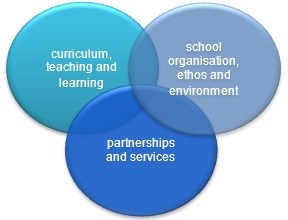Whole School Approach
A whole school approach recognises that all aspects of the school community can impact positively upon students' health, safety and wellbeing. Teaching resilience, road safety and drug education curriculum across all years of schooling using evidence-based programs; involving parents and community services; and having policies and processes in place are contributing factors to a successful whole school approach.
A whole-school approach as a concept and model acknowledges the social, political, economic and demographic contexts within which schools operate and influence health. A comprehensive whole school approach is widely recognised as best practice in working holistically to promote student health and wellbeing. By adopting this approach schools can increase engagement with the school community and are more likely to secure sustainable improvements.
A Whole-School Approach (WSA) as a concept and model varies nationally and internationally. A number of international initiatives including those from the World Health Organization (WHO), UNICEF, UNESCO, and the U.S. Centres for Disease Control and Prevention (CDC), the International Union for Health Promotion and Education (IUHPE) and others use different terms to describe holistic, comprehensive approaches in response to the health and well-being issues of students, school staff and the wider community. For SDERA, the approach involves all members of the school community, students, staff, parents and other community members. It is not just what happens in the curriculum, it is about the entire school day, advocating that learning occurs not only through the formal curriculum, but also through students‘ daily experience of life in the school and beyond. It requires schools to address the health and wellbeing of their staff, students, parents /carers and the wider community through the three key components working in unison to achieve improved health and wellbeing outcomes:
Curriculum: teaching and learning, how this is decided and the way in which teaching is delivered and learning encouraged.
Ethos and Environment: the physical environment, the ethos and values as well as the policies and structures developed to create a conducive environment for living, learning and working.
Partnerships and community links: internal partnerships with parents, staff and students and external partnerships with other schools, health workers, government and non-government organisations (WHO,1986).

Health Promoting Schools Framework (World Health Organisation, 1986)
This approach is based on an eco-holistic model, recognising the physical, social, mental, emotional and environmental dimensions of health and well-being (Parsons et al 1996). It recognises that the good health of an individual cannot be attained just through their own efforts, but that health is also shaped by the surroundings within which they live, work and go to school. The three components described above recognise these different levels of influence upon health.
CHAT (Changing Health Acting Together)
 |
Our award winning CHAT initiative provides schools with funding to support their whole school approaches in resilience, drug and road safety education. The CHAT process helps schools to audit their current efforts and plan for the future, to ensure a sustainable approach and the best health and safety outcomes are achieved for the whole school community. Having a whole school drug education plan that is documented and shared across the whole school community is protective of staff as well as students and also ensures that parents understand the school’s intentions to work proactively when drug use issues arise. |

